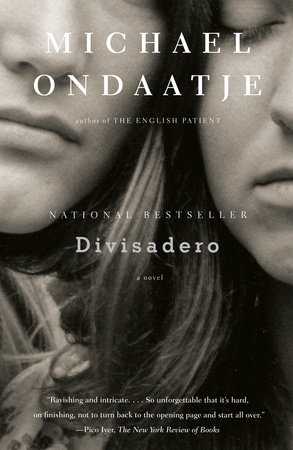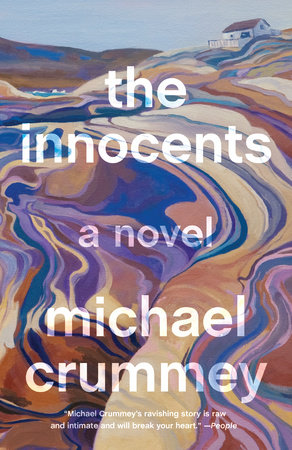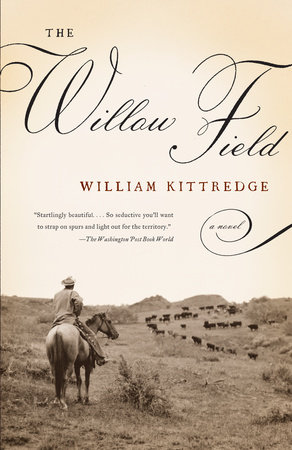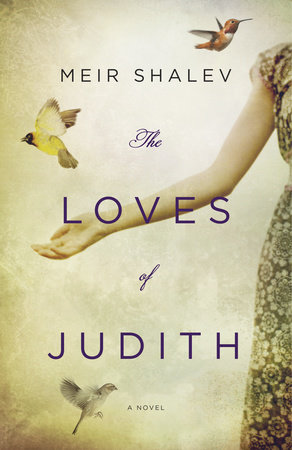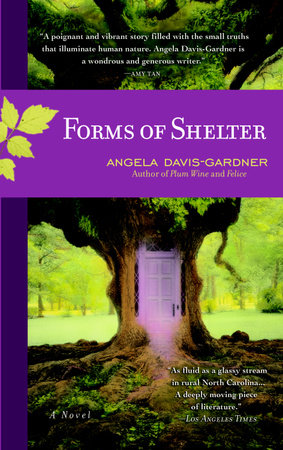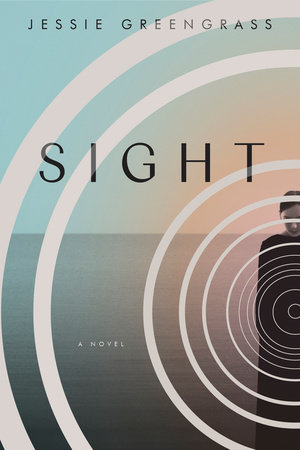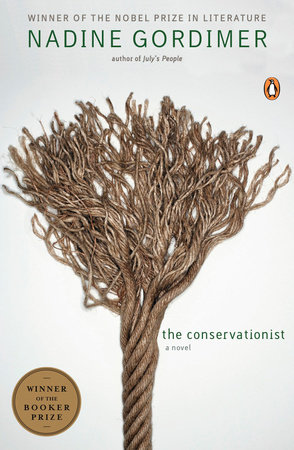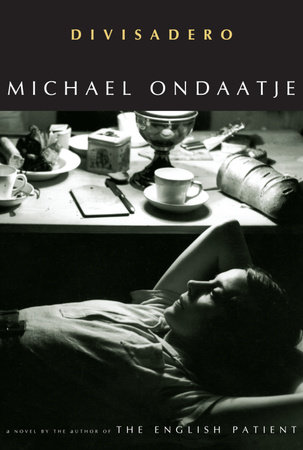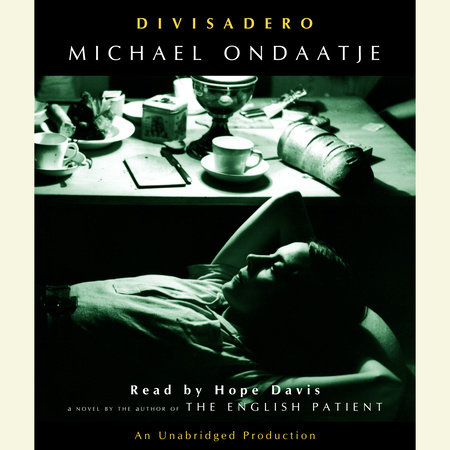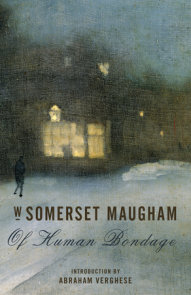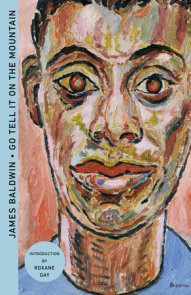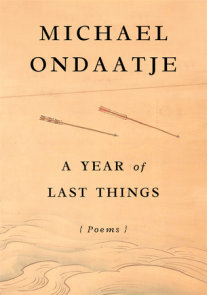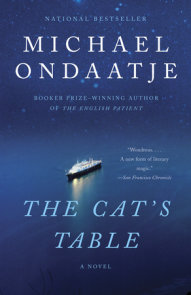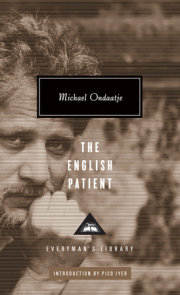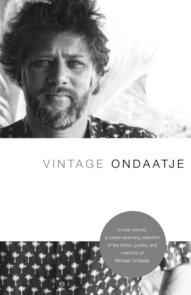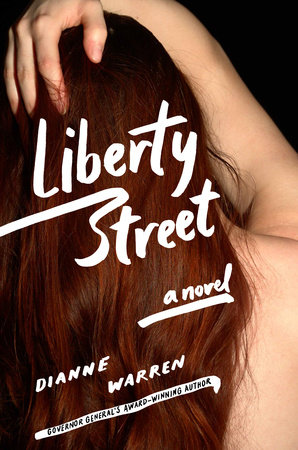Author Q&A
Q: You’ve said that you begin a book with a single image and then see where it leads you. For The English Patient it was a plane crash. What was your image for Divisadero?A: Well I was teaching at Stanford and was living north of San Francisco at the time. And I was working on a farm. Well, I mean I had a workspace that a friend gave me on her farm. And I’d heard this story about this horse going wild in a barn, and that was what began the book. That was the first scene I wrote, and I remember in this scene there was just one woman, being attacked by a horse. And that began the book. And then the landscape around the place that I was writing kind of became a part of the book, and so that area around Petaluma, which is about 45 minutes north of San Francisco, became a central landscape.Q: How long did it take you to do the research for the book in Petaluma?A: Well I didn’t really do any research. It was a book I kind of started writing there and it was just a story that I gradually invented. And I had a landscape around me. There was no real research into the habits of any kind of farm. It just became part of the story. It was just a landscape where the invented characters of Coop, and Claire, and Anna, lived. So I was writing those sequences for about 2 1/2 years. And then I would go back there every January, February and March and so that was a kind of confident landscape where I wrote the book, though I continued re-writing it when I was back in Canada.And then gradually the story of France started to come into it and I thought my God, what is this? Is this another book, or the same book? And then I realized it was the same book because of Anna’s career later in life. And then gradually I decided had to go to France to find a landscape for the writer, Lucien Segura, so I went there. I often find I need a very specific landscape to put my imaginary toes in, and I came across this house in town near Auch, near a small town named Demu, and it seemed the right place for this writer. And I was there very briefly for the first time–about 15 minutes–and when I came back to Canada that world–that house, that garden and the small lake there–sort of took over. And so the whole French section began and so it became a kind of partner to the California section of the book.Q: The book starts with 3 young people and takes them from their early teen years until middle age and you see what happens to them. The story in France also involves people as they get older, and how they completely change through events that shape them. Do you think people can really walk away from an earlier life and start a brand new one?A: I think they do. I think all of us do. We all, hopefully, well maybe not hopefully, reinvent ourselves at certain points in our life. I mean I know when I first came to Canada at the age of 18 or 19, there was a kind of reinvention. I was coming to a new country. I was studying English literature, which was a whole new world for me, and I was in a new place, with a new life. I think I did change a great deal, I kind of I evolved. It’s the way Gertrude Stein talks about being an American and coming to France and, you know, France remade her. I think that happened to me in Canada. And I think that the idea of the family is quite interesting. We think of a family as a kind of a very nuclear thing, and the family in my book is not a nuclear family. It’s kind of made up of various other families in some odd way. But we live with a family for the first 15, 16 years of our lives and then, often we scatter. We don’t see each other or one becomes a doctor, one becomes something else. And that is quite a bizarre structure in our lives: that we are this nuclear thing and then we splinter out into other worlds. So I was very interested in that as a kind of form. What would happen, how connected are we later in life.Q: How long do your characters stay with you when you finish the book and do you imagine what happens to them beyond the book?A: Well I tend to try and keep a kind of open door at the end of my books so that people don’t get closed off, they don’t get locked into a career or a type or a final state. For example, I see Claire’s continuing a life with or without Coop, or Anna continuing to have a life with or without Rafael. I discover people as I write the book and I certainly don’t want to cut them off in the end into a kind static state, so I really do imagine their lives beyond the books. I imagine their lives also during the book when they’re offstage, as it were.Q: Well that makes sense, because that’s more like real life anyway.A: Yes exactly, like when we have friends, these people, who in 2 years they come back as a politician, and we ask ourselves how the hell did they do that?Q: You write about Lucien, the writer, and say “for most of his life he’d been regarded as a solitary, in spite the gregarious situation of his family, he’d lived mostly an imaginary life” and that “his fictional character Claudile had kept him company over difficult times.” Is that the case for you, or can you have a social life in the middle of the book? A: Well, I think there are obviously grains of myself in Anna, and Coop, in all the characters. They are sort of inventions of oneself. They are creations that come out of some part of yourself. Or some part that interests you, not necessarily what you are. So I think if you’re a writer and you write during the day, those characters become very active in your life. I mean I never feel alone when I’m writing. I feel, hey, I’ve got to talk to Coop, or something. You may be alone in a room but, for a number of hours a day, you’re in a world that is populated by 5 or 6 people. And I think that Lucien’s more of an extreme case of someone who has kind of retreated from the world almost completely–from his family for a while, for various reason–and so he lives with those invented characters.Q: Whereas you’ve said you can go out and be with people . . . sometimes. But you don’t talk about the book.A: No, I never talk about the book. I’m one of those awful writers who keeps to himself for the duration of the book. So it’s kind of like a paper in one’s pocket that’s not revealed for a long time.Q: And when you do reveal, is it in one fell swoop, all at once?A: Yes, what I do is after about 5 or 6 drafts, or many times more, when I’ve taken it as far as I can go by myself, I then find 3 or 4 people who I trust enough to give it to who will then respond to it. And then, after those responses, I go back and work on it again for another year or so. So those are really kind of useful. By that point, I’ve got the story, physically sort of finding: Is this the right shape, is this the right pacing? Is this the right detail, does one character seem weak? Do I need to build that character up a bit more? So all those things come in at this second stage of rewriting.Q: So you really are taking on board any kind of constructive criticism?A: Well I don’t always agree with it. Not everything they say, I do. But it is important to me as I’ve been living in a kind of solitude with the story for so long that sometimes I don’t realize that one character has sort of disappeared, or something like that, you know? That’s the great joy of a book as opposed to a film. A film has already been filmed. They’ve already been to Spain and Portugal so they can’t go back, unless they’ve got a lot of money. Whereas, with a book you can turn someone into a Scotsman and have much less expense. Q: One of the parts of the book deals with Coop becoming a gambler, so you write intriguingly about gambling, particularly poker. Is this something you had to learn or is it something that you already knew? A: I knew a little bit, but I really didn’t know that world at all. I knew how to play poker, not that I play poker a lot. But I suppose I should pretend that I play a lot, I guess. Q: But you did a little research?A: I did go to Vegas but I didn’t really like Vegas very much. I went there rather late in the day. But it just seemed such a kind of unreal place, and it was unreal when I got there, whereas Lake Tahoe was a bit more modest, and it’s more like real life. So I went to Tahoe several times and I talked to full-time gamblers. I didn’t want to talk to weekend gamblers and all that. So I did do that and hung around and had dinners with them. I didn’t watch the game because the game was already in my head, that is, the invention of the game. But I did talk to them a lot. I’d ask them: “What would you do?” “How would you do this?”And, I met a magician who was also an incredible card player, and I talked to him about stuff. It was a very interesting world. What was interesting about inventing that world was not so much how they won or how they lost, but their general behavior–just how they lived their lives. In the morning, their TVs were always on mute. It was almost a way of watching TV, but it wasn’t. You were watching the visuals, but you were talking about something else or playing cards or something like that. So little details like that grew out of my knowledge of it.Q: A small point about those gamblers, you have them talking and agreeing about the worst movie ever as being Brian DePalma’s The Fury. Where did that come from?A: I know I’m going to hear about that. I just saw that film and thought it was a terrible film. You know, I think this–it’s not me. Tell Brian DePalma, this is not me. There was such panache in the way some of these people spoke, they were so sure about things. It was: What was the best drug, What was the best breed of dog. So I just went with that and so I was allowing a kind of outrageous certainty about what is the best film or what is the worst film. . . . I really hope it’s not one of David Thomson’s favorite films!Q: One of the card players says, and again this may fall under that heading of outrageous certainty, “There’s nothing more seductive to a man that a woman in distress.” True?A: Yes, again I think this is not me. The character of the Dauphin talks about it, and I think that’s him, and his world. And also it’s something that comes up later in the book with another character in the desert. And it’s also, I think, a sort of set-up of a kind of noir quality, in what happens to Coop.Q: Yes, speaking of noir, one of the chapters is even named “Out of the Past.”A: Yes, I had a lot of “Out of the Past” that I took out out of the book, at one point. But that kind of woman in distress who fools you–that is an element, something in the plot, to some extent. So that was a preparation for that, I guess.Q: The title of the book, Divisadero, as you say in the book, has at least 2 meanings: It’s a street in San Francisco from the Spanish word for “divide,” but it also means “gaze from afar” in Spanish. How did this come to be the title of this work?A: To be honest, it began as a word I love. The first time I saw it, many, many years ago, I just loved that name: it had, first of all, more vowels than my own name, which is rare! And it was the sound–a great word. I would drive past or along Divisadero so often, and then gradually it seemed to me that it was a kind of apt title, not just for the meanings that you mention of being a division and also to look at something from afar the way Anna does, from France, from afar, or interpret the past in some way about her own life. But the book is sort of in two sections that link up very closely. There is a divide, there is a divider, in the book, so it seemed very apt in some way.Q: And finally, you write a beautiful passage about childhood, when you write about Rafael as a little boy with his mother: “There were evenings when Aria and Rafael stood on dry night-grass with a hundred layers of stars above them. Uncountable. A million orchestras. . . . It was when he felt most clearly that there was no distinction between himself and what was beyond him–a tree’s sigh or his mother’s song, could, it seemed, have been generated by his body. Just as whatever gesture he made was an act performed by the world around him.” Is that also your idea of that blissful state of childhood?A: I think so. I think that it’s not just childhood. There are times when that does happen to a person, or when one is in love or when one makes something. It’s where everything kind of merges, and it’s that very rare thing and it doesn’t happen all the time, obviously, but if for Rafael, who’s also the portrait of the artist in the book, it’s what limits that artistic moment, so if I limit it to art, obviously, it’s that moment where everything kind of coalesces, I guess. Probably is closer to childhood than adulthood, in many ways, but hopefully it happens again, at least once.
